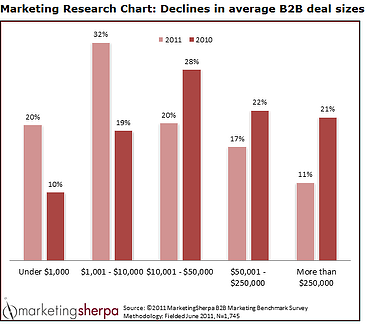Sales Pipeline Under Pressure?
In a recent MarketingSherpa research article, we learn that the average deal size for B2B companies declined in 2011 compared to 2010. The following chart from the article shows clearly that deals less than $10,000 increased substantially while deals over $10,000 dropped accordingly.
Q. Please select the range that best represents your organization’s AVERAGE SALE AMOUNT, or average deal size per customer.

What's driving the decline?
Growing your business starts with creating awareness and need. You succeed when customers see the need, know of your solution and take action. For many we work with, that's not a given — the greater the innovation, the bigger the challenge in finding and educating the right buyers.
In a tough economy, the push to close deals fast trumps selling more complex deals that take longer to close. Many B2B companies use promotions and other price-related incentives to convert leads in the pipeline-fast. The problem with this approach is that competing on price rather than value will continue to undermine average deal size even when the economy improves.
The use of promotion can be an effective tool however we advise our B2B clients to use price incentives very sparingly. We prefer offering extra service such as accelerated delivery instead of a price incentive.
Even though a promotion can move an "easy" sale to a close quickly, the larger and more complex deals must be planned for on a longer sales time line. This is where a well crafted marketing strategy that synchs up with your sales efforts can help.
Sales funnel best practices
The larger deals will be in the funnel longer and you need to have a process for moving them along. Through regular touches, your funnel process must engage and qualify / re-qualify leads through each pipeline stage. The process includes having a lead scoring or lead prioritization approach so that your sales people are focusing on the deals at a point the prospective customer is ready to buy.
Does your funnel process consider these best practices?
- Target highest value prospects / projects – this is obvious however many clients do not have a clear definition of the most valuable prospect or a system to score prospects.
- Focus on the entire funnel. Here we are referring to three areas of the funnel – at the top of the funnel marketing’s role is to target and attract the right prospects to your company. The middle of the funnel nurtures them with regular and frequent touches. The bottom of the funnel supports the sales conversion.
- Regular touches. Do you regularly touch customers and prospective customers across multiple channels or touch points? Prospective customers hang out in several different places. At the top and middle of the funnel in particular, it’s important to span your reach across several places (e.g., web, social, associations, etc).
Please weigh in with your comments. If you have questions on your sales pipeline or moving deals through it, don't hesitate contacting us for a free, no-obligation consultation.
